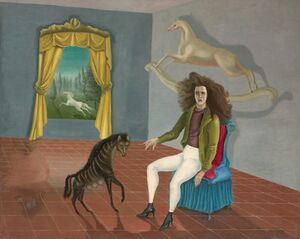Course:Leonora Carrington's Self Portrait
| CRWR 501P 003 |
|---|
 |
| Advanced Writing of Poetry |
|
| Important Course Pages |
| Categories |
Leonora Carrington’s “Self Portrait: The Inn of the Dawn Horse”
I first came across Leonora Carrington as an author rather than a painter. A woman surrealist artist who was engulfed by other more well-known men artists – Salvador Dalí, Marcel Duchamp, Max Earnst, Man Ray, etc. – her illustration of the female sexuality and her push against the idea of being a “muse” in both her writings and paintings became something that I’ve learned a lot from, and something that I’m continuing to experience. The Self Portrait was painted in 1937, with herself sitting in an armchair next to a hyena. A white rocking horse is placed on the wall behind her, echoing that of a real white horse running outside the window on the adjacent wall. Something primal rings from this painting: her own unruly hair, the androgynous clothing, the hyena, the absence of a person on a rocking horse. To me, this painting is not only a wild depiction of her alter-ego (since this is named Self Portrait), but also a rebellion against and transformation of her surrealist compatriots’ idea of women being objects of men’s desires. Albeit the radical manifestos and expressions, men surrealist artists were very much behind on their concepts of women, including also women artists. What were women but muses to the creator, serving as artistic inspiration to generate more surreal work?

Along with what I choose to read and write, I think that female sexuality and that of being and identifying as a woman will always be something that I’m considering at the forefront. In my poems, the speaker is almost always inhabiting a woman’s body with a woman’s voice. Experimenting with words in my poems, like Carrington, I feel as if “I’m like a hyena, I get into the garbage cans. I have an insatiable curiosity.” I’m trying out different effects that might result from using different verbs, or mixmatching adverbs in place of adjectives. Will it work in the logical, grammatical sense? Can there be as much experimentation in sentences as there is in Carrington’s paintings?
Categories
Add categories here